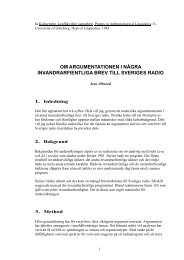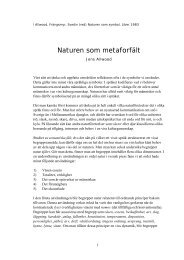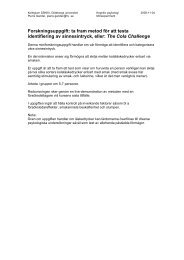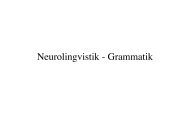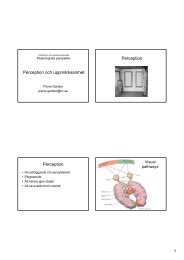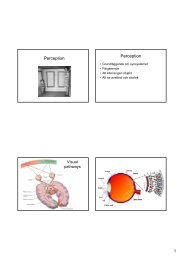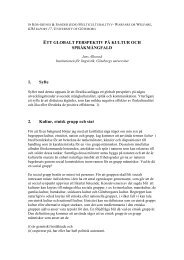Intonation Patterns in Nepali Feedback Units
Intonation Patterns in Nepali Feedback Units
Intonation Patterns in Nepali Feedback Units
Create successful ePaper yourself
Turn your PDF publications into a flip-book with our unique Google optimized e-Paper software.
GFB unit baai 'bye' has fall<strong>in</strong>g <strong>in</strong>tonation <strong>in</strong> another<br />
case (see Table 6). This confusion can also be resolved<br />
with the help of context. The example with ris<strong>in</strong>g<br />
<strong>in</strong>tonation baai 'bye' is the only FB unit used by a child<br />
speaker among the FB units studied here. Thus it can<br />
be taken as non-representative item s<strong>in</strong>ce the child<br />
speech is generally not stabilized.<br />
Table 6. <strong>Intonation</strong> pattern of GFB Accept<br />
FB Unit <strong>Intonation</strong><br />
la 'ok', la baai 'ok bye', m 'yes', haN 'mm', Fall<strong>in</strong>g<br />
baai 'bye', oke 'ok', aN huncha 'yes it is',<br />
m 'yes', ho 'yes, haN Thik cha 'yes its ok',<br />
la ta ni 'ok', aNhaN/ahaN 'no', has 'ok',<br />
dhannebaad 'thanks', has hazur has 'ok ok'<br />
baai 'bye' Ris<strong>in</strong>g<br />
Table 7. <strong>Intonation</strong> pattern of GFB Non-accept<br />
FB Unit <strong>Intonation</strong><br />
aN 'no', aNha 'no', naai/naaiN 'no', aNkha 'no', Ris<strong>in</strong>g<br />
naai/naaiN 'no', ho<strong>in</strong>a 'no'<br />
Additional <strong>Feedback</strong> expressions that are used for<br />
the expression of attitudes and emotions can be<br />
grouped <strong>in</strong>to two categories. These feedback units<br />
function add extra <strong>in</strong>formation related to the thoughts<br />
and feel<strong>in</strong>gs of the <strong>in</strong>terlocutors.<br />
We have studied feedback expressions with<br />
<strong>in</strong>tonation patters correspond<strong>in</strong>g to the attitudes<br />
Certa<strong>in</strong> and Uncerta<strong>in</strong>, Interested and Un<strong>in</strong>terested,<br />
Agreement and Disagreement, Satisfied and Other <strong>in</strong><br />
this paper. We have also studied expressions with the<br />
emotions/attitudes Surprised, and Angry<br />
Both the Certa<strong>in</strong> and Uncerta<strong>in</strong> <strong>Nepali</strong> GFB units<br />
of Additional Attitude have been found to use fall<strong>in</strong>g<br />
<strong>in</strong>tonation pattern as presented <strong>in</strong> the Table 8 and<br />
Table 9 below. However, there is one exception <strong>in</strong> the<br />
GFB Additional Attitude Certa<strong>in</strong> ho 'yes' which has a<br />
ris<strong>in</strong>g <strong>in</strong>tonation pattern. Though it needs to be<br />
exam<strong>in</strong>ed <strong>in</strong> more data to confirm this generalization,<br />
the speaker of this example has been attested to be a<br />
non-native speaker of <strong>Nepali</strong>.<br />
Table 8. <strong>Intonation</strong> pattern of GFB Additional,<br />
Attitude, Certa<strong>in</strong><br />
FB Unit <strong>Intonation</strong><br />
aN cha 'yes it is', aN ekdamai 'yes certa<strong>in</strong>ly', Fall<strong>in</strong>g<br />
ho ta 'yes', hazur aN 'yes yes', ho ta ni 'yes it<br />
is', ho ni 'yes it is', um 'mm', cha ni 'yes it is'<br />
ho 'yes' Ris<strong>in</strong>g<br />
Table 9. <strong>Intonation</strong> pattern of GFB Additional,<br />
Attitude, Uncerta<strong>in</strong><br />
FB Unit <strong>Intonation</strong><br />
khai 'may be', holaa 'may be' Fall<strong>in</strong>g<br />
In <strong>Nepali</strong>, both expressions that show <strong>in</strong>terest and<br />
un-<strong>in</strong>terest have been found to have both fall<strong>in</strong>g and<br />
ris<strong>in</strong>g <strong>in</strong>tonation patterns, however, fall<strong>in</strong>g <strong>in</strong>tonation<br />
pattern is found to be basic to these GFB units. The<br />
justification for this claim is that all the units of<br />
Interested and Un<strong>in</strong>terested GFB with ris<strong>in</strong>g <strong>in</strong>tonation<br />
pattern are either used as turn holders and therefore<br />
probably also have an OCM function, or their second<br />
element is function<strong>in</strong>g as an EFB unit at the same time<br />
<strong>in</strong> the case of phrasal FB units. Ani 'then/and' and aru<br />
'then/other' <strong>in</strong> the examples presented <strong>in</strong> Table 10 and<br />
11 below are function<strong>in</strong>g as feedback giv<strong>in</strong>g and<br />
elicit<strong>in</strong>g units at the same time.<br />
Table 10. <strong>Intonation</strong> pattern of GFB/EFB<br />
Additional, Attitude, Interested<br />
FB Unit <strong>Intonation</strong><br />
aN ho 'yes', zhan 'even', aN 'mm', e la 'O ok', Fall<strong>in</strong>g<br />
haN 'O', pliz 'please', hazur ani 'ok then', e he<br />
'O', e aN aN 'O yes yes'<br />
e ani 'ok then', ho ani 'yes and', e aru 'O then', Ris<strong>in</strong>g<br />
aNha 'mm'<br />
Table 11. <strong>Intonation</strong> pattern of GFB/EFB<br />
Additional, Attitude, Un<strong>in</strong>terested<br />
FB Unit <strong>Intonation</strong><br />
hyaa 'I don't care' Fall<strong>in</strong>g<br />
hyaa 'I do not care' Rais<strong>in</strong>g<br />
Agreement and Disagreement of GFB units of<br />
Additional Attitude also have fall<strong>in</strong>g <strong>in</strong>tonation as <strong>in</strong><br />
the examples m 'yes' (Agreement), naai/naaiN 'no'<br />
(Disagreement).<br />
The <strong>Feedback</strong> unit hai, express<strong>in</strong>g satisfaction, has<br />
been found hav<strong>in</strong>g a ris<strong>in</strong>g <strong>in</strong>tonation pattern.<br />
Similarly, the unit ThikThaak 'f<strong>in</strong>e', express<strong>in</strong>g<br />
satisfaction of positive evaluation, also has fall<strong>in</strong>g<br />
<strong>in</strong>tonation.<br />
The FB units express<strong>in</strong>g Surprised have been found<br />
to have a fall<strong>in</strong>g <strong>in</strong>tonation pattern. However, there<br />
were two exceptional cases where the FB unit also<br />
functions as a turn holder at the same time. They have<br />
ris<strong>in</strong>g <strong>in</strong>tonation. Thus, the general trend for FB units<br />
express<strong>in</strong>g surprise is that they have fall<strong>in</strong>g <strong>in</strong>tonation<br />
<strong>in</strong> <strong>Nepali</strong>. The examples of GFB Additional Emotion<br />
Surprised are presented <strong>in</strong> Table 12 below.<br />
Table 12. <strong>Intonation</strong> pattern of GFB Additional,<br />
Emotion, Surprised<br />
FB Unit <strong>Intonation</strong><br />
abi 'wow', baaphre 'it is very strange', lau Fall<strong>in</strong>g<br />
'wow', lau 'wow'<br />
e 'O', laa 'O' Ris<strong>in</strong>g<br />
For GFB the additional emotion, anger; um la la<br />
'ok' also have fall<strong>in</strong>g <strong>in</strong>tonation.



